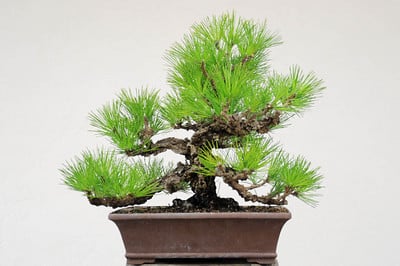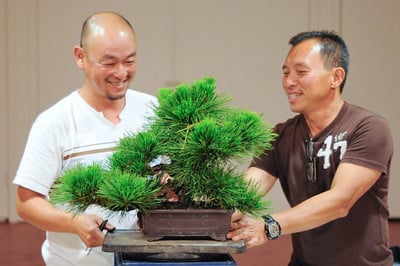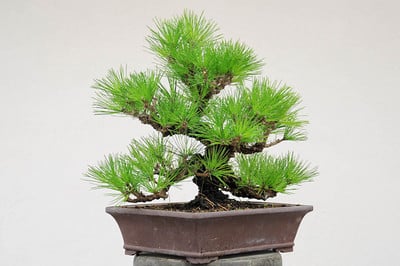The yatsabusa corkbark black pine below is almost 17 years old. I’m primarily growing it as a source for future grafting projects, but it’s become a fun project. I pulled the old needles and removed a few shoots that were growing in dense areas. That should do it for this year. Soon I’ll start fertilizing the tree and before I know it the spring growth will fill in the gaps.

Yatsabusa corkbark Japanese black pine – Fall 2010

After cutback
As the photo makes clear, the tree is a bit two dimensional. The current shape of the tree emerged during a BIB monthly meeting in August, 2009. Akio Kondo, visiting from Japan, cut back unnecessary growth and pulled old needles in a stretch of maybe five minutes. It was remarkable – not a needle was bent (see “Akio Kondo critique” for details).

Akio Kondo and Boon Manakitivipart size up the tree
To break up the monotony of the flat branches, I’m thinking of selecting a new front, about 50 degrees left of center. This gives the tree some depth and downplays the similarity between the first two branches on the left.

Possible new front
I’m hoping the tree will grow much larger in the coming years. Corkbark black pines can make dramatic bonsai and can generate great bark in far less time than comparable non-cork bark pines. It may be another 5 or 10 years before I can show it, but I expect the tree to provide me with plenty of entertainment in the mean time.
Subscribe to Bonsai Tonight
New Posts Delivered Every Tuesday and Friday
albert says
helcome you don’t stick it in the grown for a few years rather then leaving it in a pot. Slowing down the growth with limited root space? Especially if you want an increased size in the trunk.
xwires says
Hi Albert – good question. I’m keeping it in a pot for two reasons: one, I’m not in a rush; and two, the tree is portable. When I start more trees with this foliage, I’d like to grow some in the ground. I’d like to grow the rest in pots so I can bring them to workshops and learn more about caring for them throughout their development.